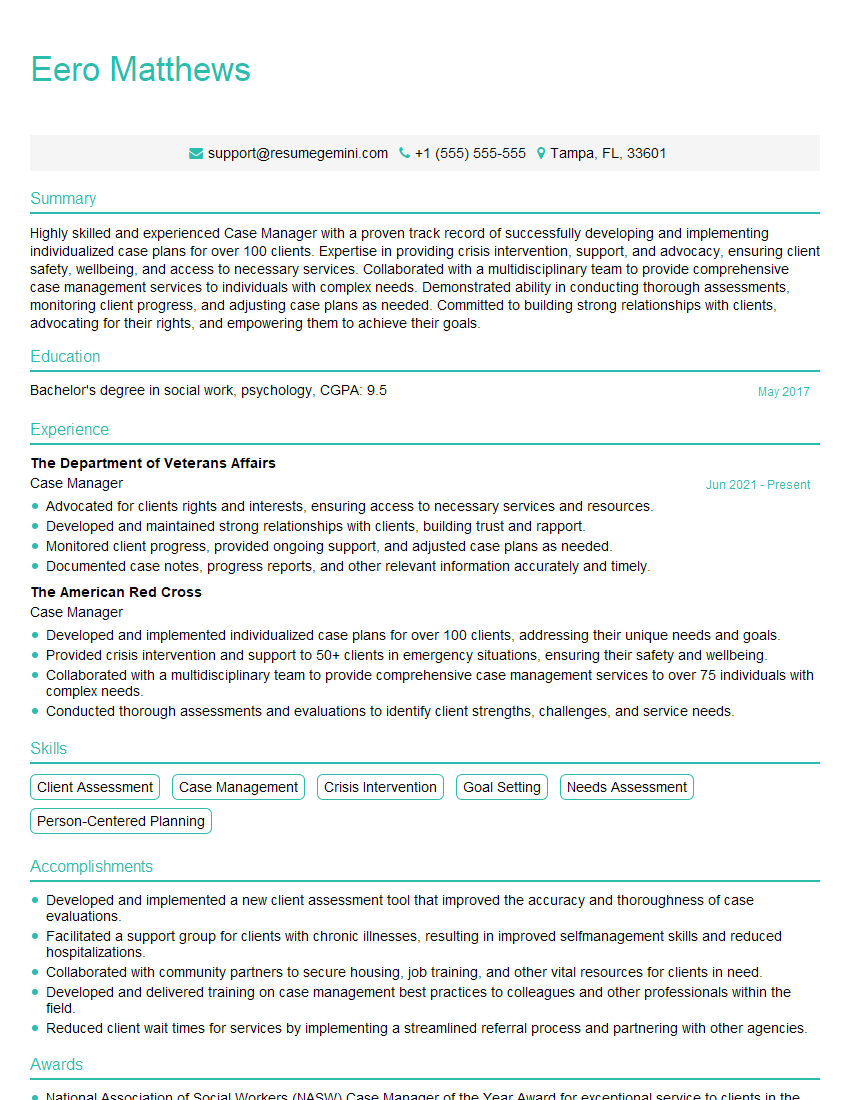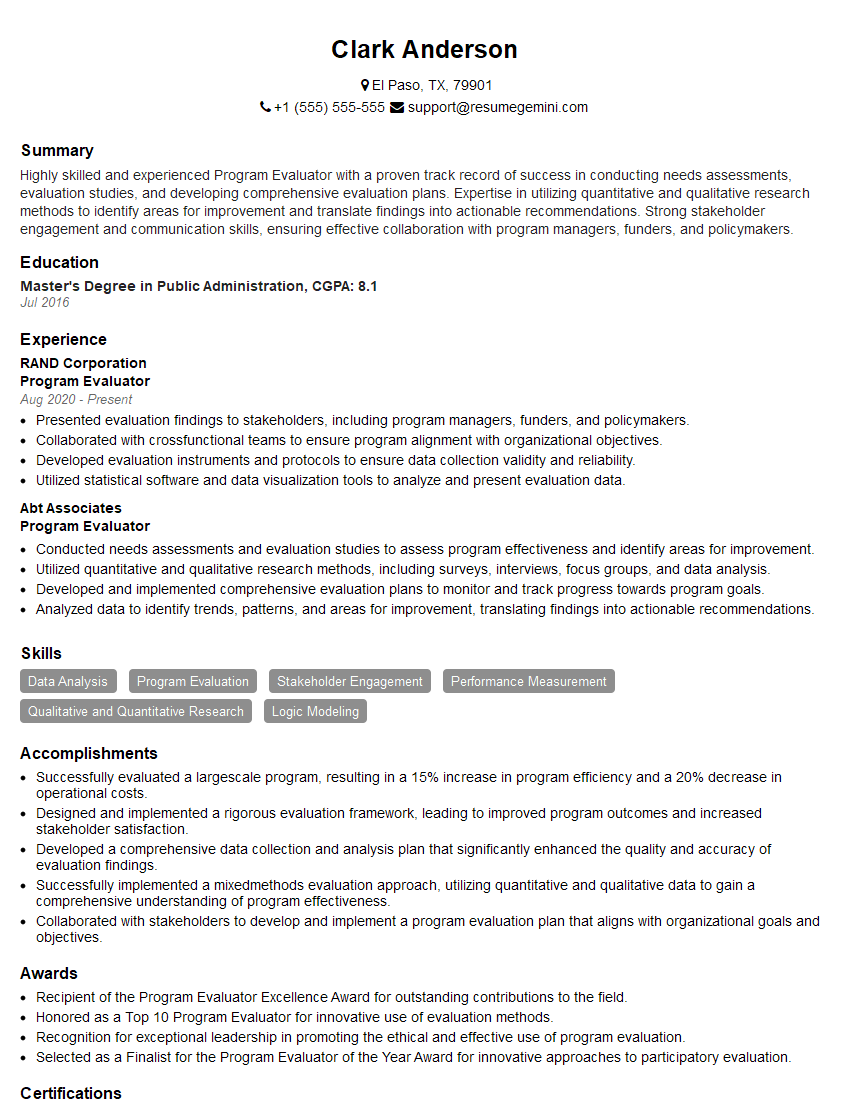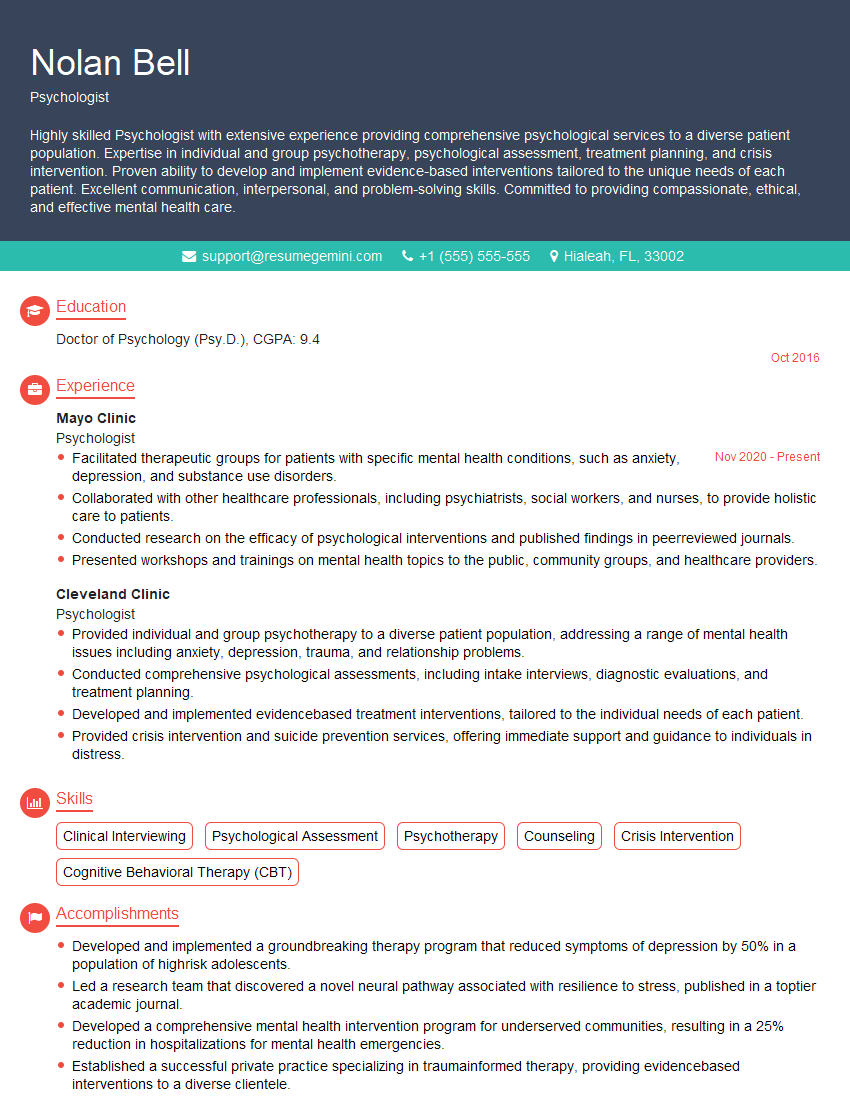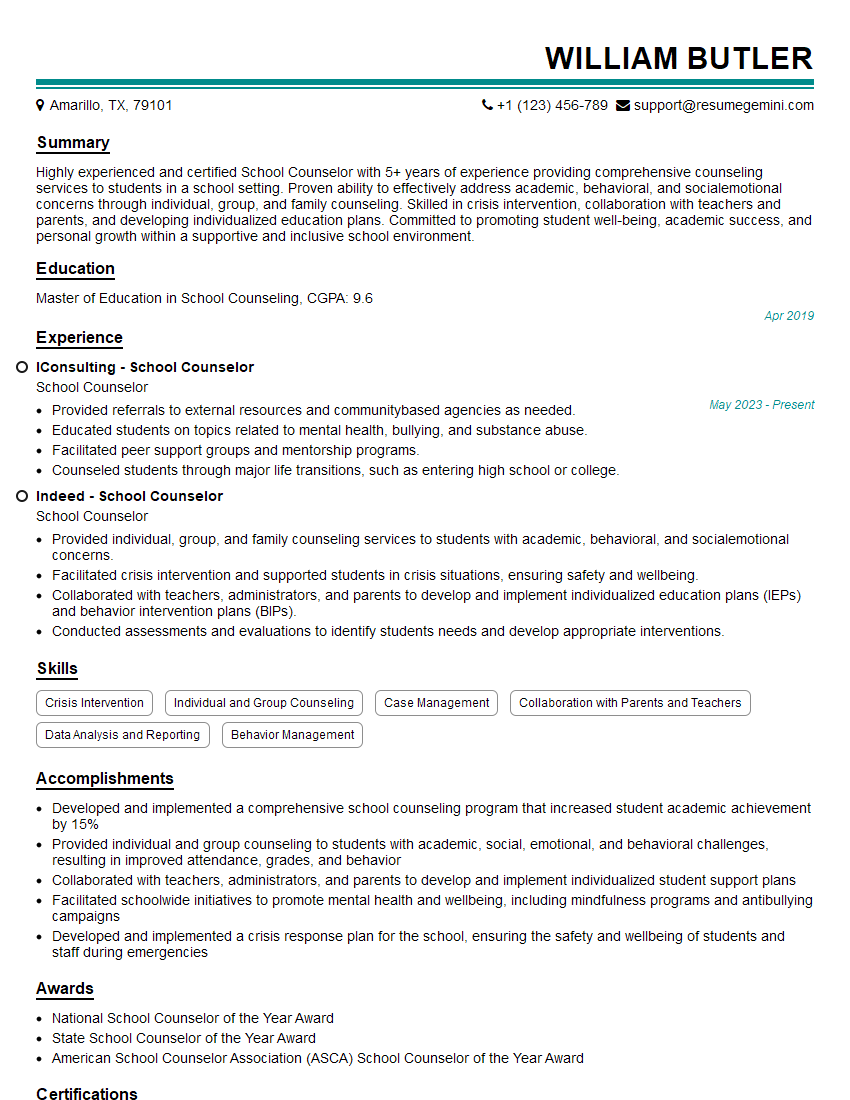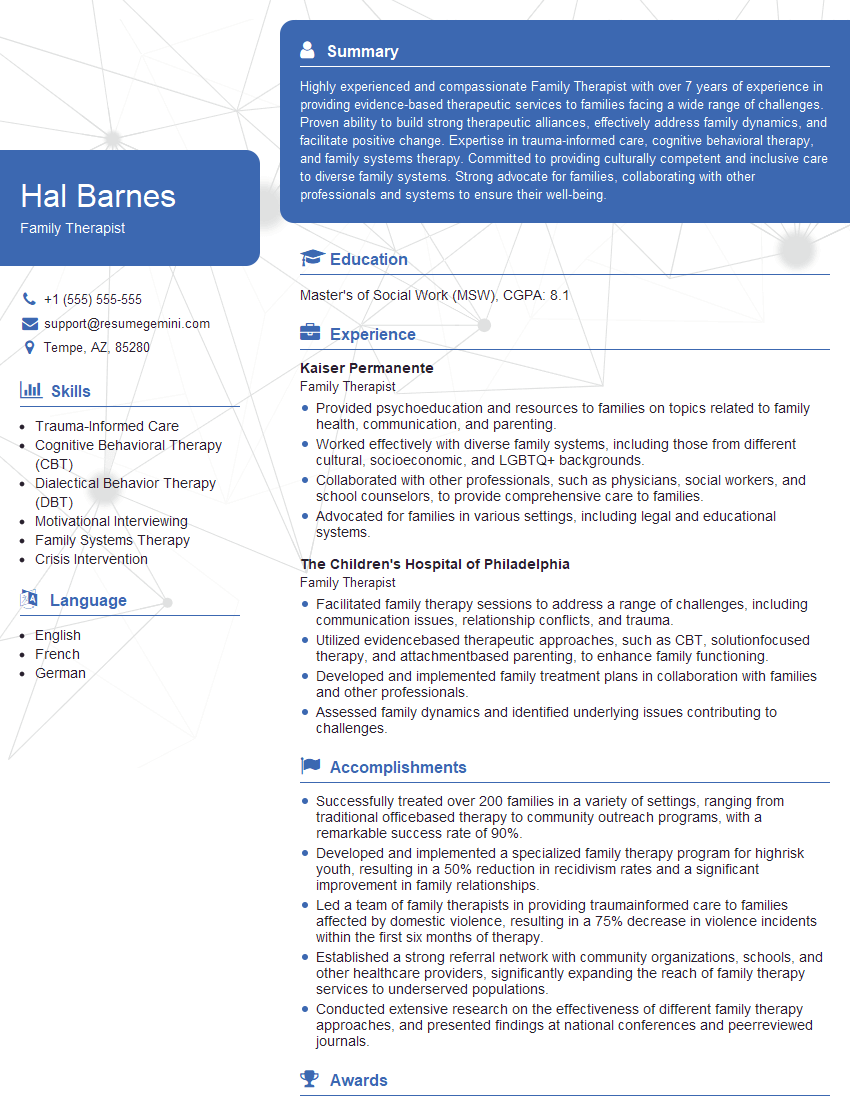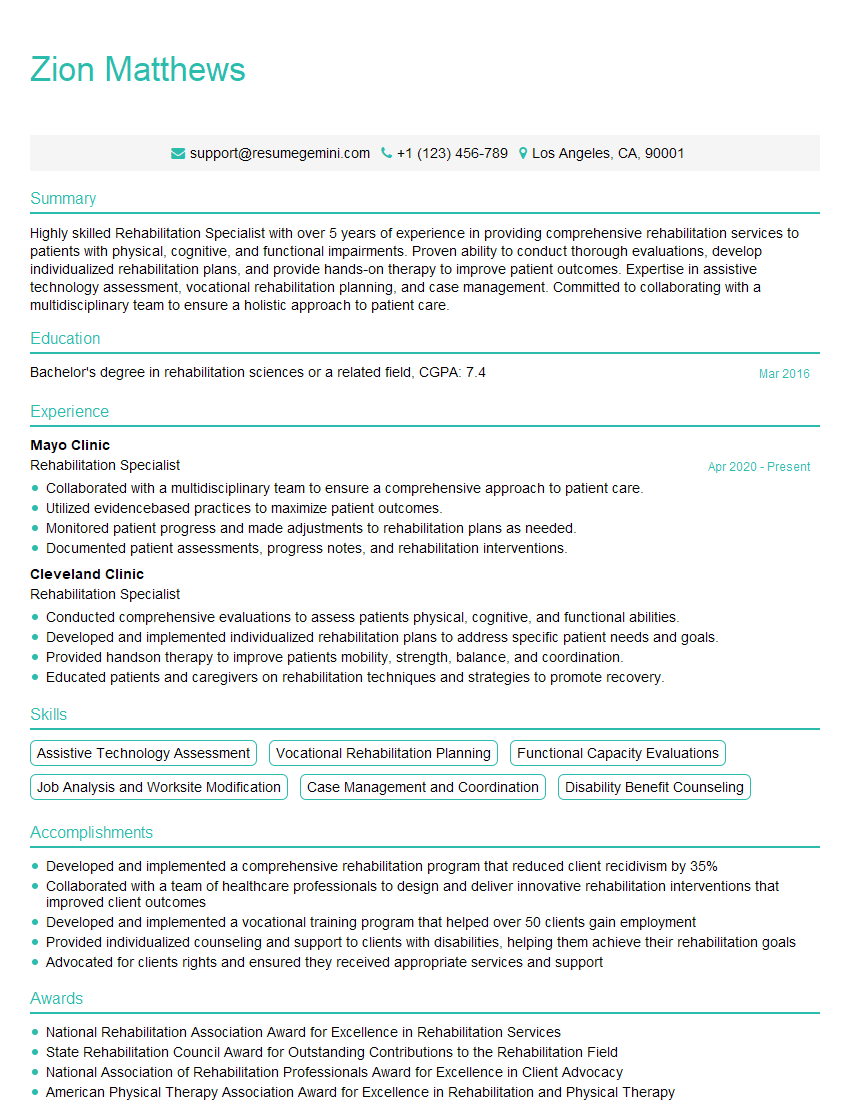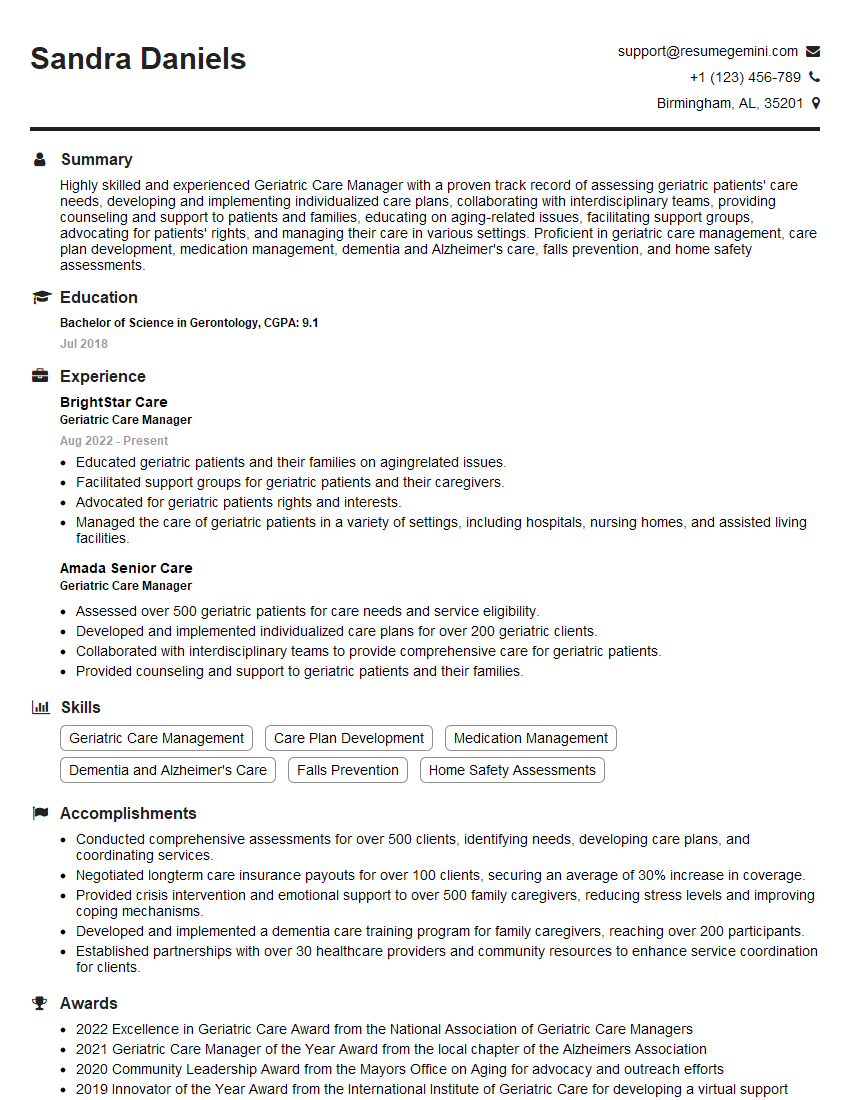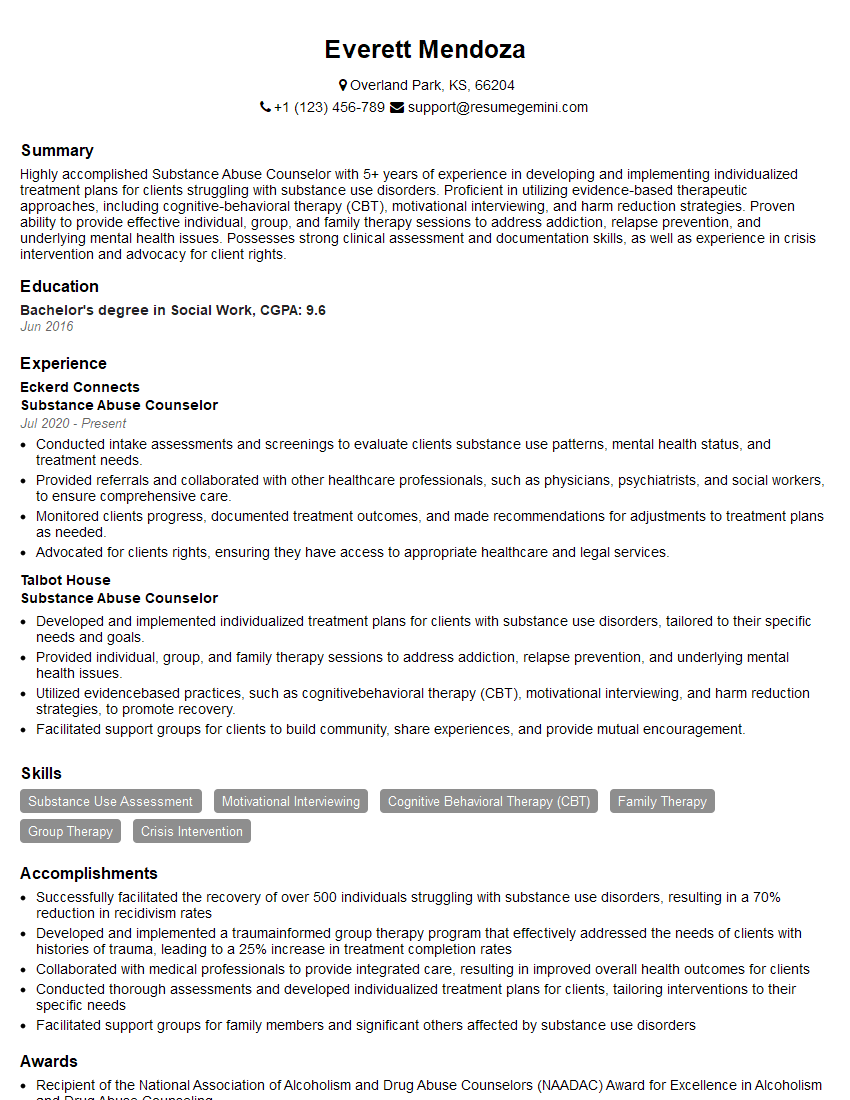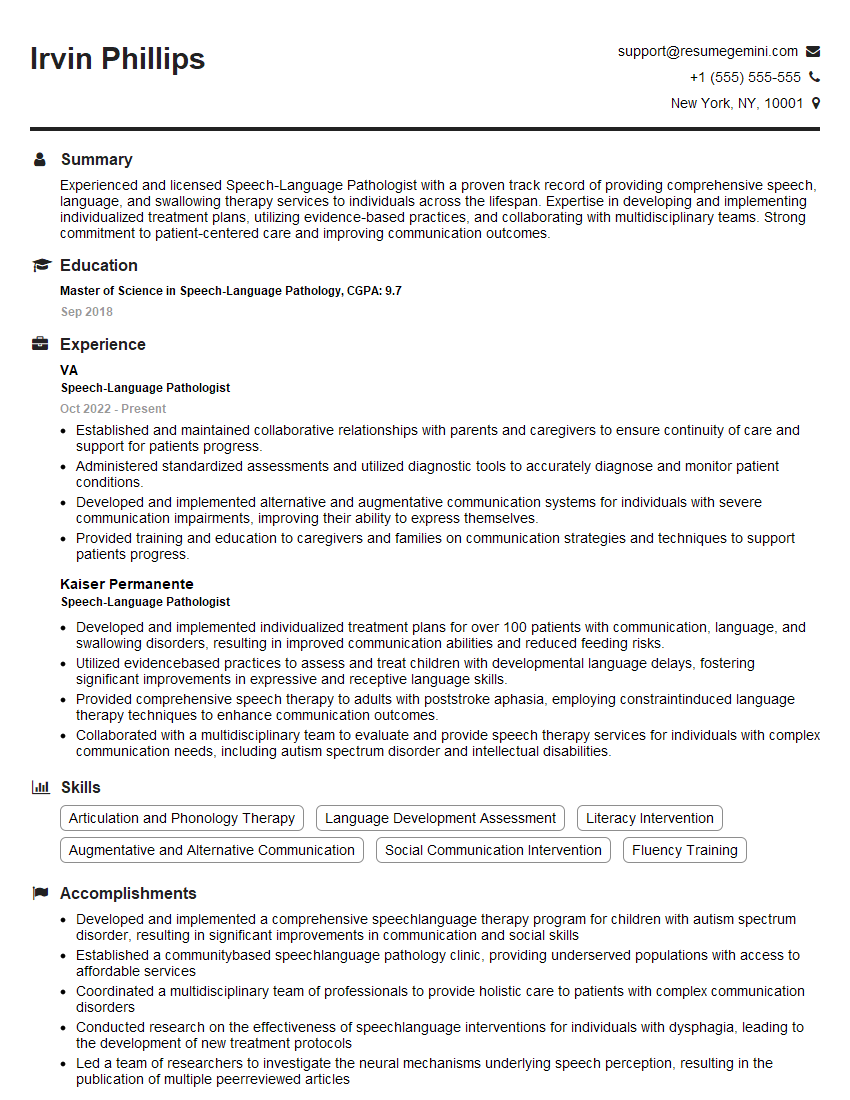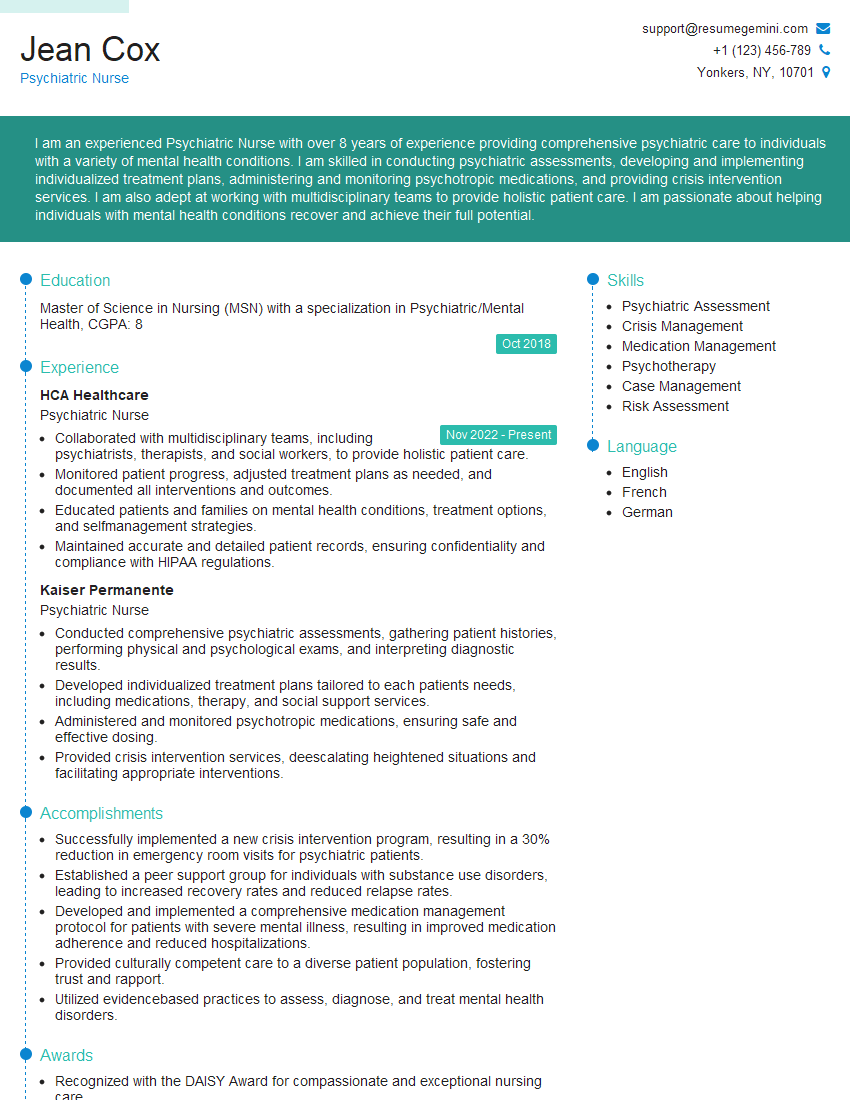Are you ready to stand out in your next interview? Understanding and preparing for Client Assessment and Diagnosis interview questions is a game-changer. In this blog, we’ve compiled key questions and expert advice to help you showcase your skills with confidence and precision. Let’s get started on your journey to acing the interview.
Questions Asked in Client Assessment and Diagnosis Interview
Q 1. Explain the process of conducting a comprehensive client assessment.
A comprehensive client assessment is a systematic process of gathering and interpreting information to understand an individual’s needs, strengths, and challenges. It’s like building a detailed map before embarking on a journey – you need to know your starting point, your destination, and the potential obstacles along the way. The process typically involves several key steps:
- Intake and Referral Information: Reviewing initial information such as referral sources, reasons for seeking help, and any available background information.
- Initial Interview: Conducting a structured interview to gather information about the client’s history, presenting problems, current functioning, and support systems. This is where you establish rapport and build trust.
- Collateral Information: Gathering data from other sources, such as family members, previous therapists, medical records (with appropriate consent), or school records. This provides a more holistic view.
- Assessment Tools: Utilizing standardized tests, questionnaires, or observational methods to gather objective data. These tools provide structured measures of specific aspects of functioning.
- Diagnosis and Case Formulation: Integrating all collected information to formulate a comprehensive understanding of the client’s situation, potential diagnoses, and treatment goals. This is the map creation phase.
- Treatment Planning: Developing a collaborative treatment plan based on the assessment findings, client preferences, and available resources. This is charting your course to the destination.
For example, in assessing a child struggling with school, we’d gather information from parents, teachers, the child themselves, and potentially use standardized assessments of cognitive abilities and learning styles. This multi-faceted approach ensures a thorough understanding.
Q 2. Describe different methods for gathering client information.
Gathering client information involves a variety of methods, each with its strengths and limitations. Think of it like using different tools in your toolbox to get the job done. Some common methods include:
- Interviews: Structured or unstructured conversations to gather subjective information directly from the client. This is crucial for understanding their perspective and lived experiences.
- Questionnaires and Self-Report Measures: Standardized or customized forms that allow clients to provide information about themselves. This method is efficient for collecting large amounts of data.
- Observations: Directly observing the client’s behavior in different settings. This can be particularly valuable in assessing children or individuals with communication difficulties.
- Collateral Information: Gathering information from other sources, such as family members, medical professionals, or school records. This provides valuable context and corroborative information. Remember, always obtain informed consent before contacting third parties.
- Psychological Tests: Standardized tests that measure various aspects of cognitive functioning, personality, or emotional states. These tools are helpful in objective measurement and are used to rule out organic causes.
For instance, in assessing for anxiety, I might use a combination of a clinical interview to explore the client’s experiences, a self-report measure like the GAD-7 to quantify anxiety symptoms, and observe their behavior during the session to note any signs of anxiety.
Q 3. How do you ensure client confidentiality during the assessment process?
Client confidentiality is paramount. It’s the cornerstone of the therapeutic relationship and essential for building trust. Maintaining confidentiality involves several strategies:
- Informed Consent: Clearly explaining to the client how their information will be used, stored, and protected. This includes discussing limits to confidentiality, such as mandated reporting.
- Secure Storage of Records: Keeping all client records in a secure, locked location, both physically and electronically. This includes password-protected electronic files and HIPAA-compliant systems.
- Adherence to Ethical Guidelines: Following professional ethical guidelines related to confidentiality, such as those established by relevant professional organizations (e.g., APA, ACA).
- Limited Disclosure: Only disclosing information when legally required (e.g., mandated reporting of child abuse or threat of harm to self or others). Even in these cases, only the necessary minimum information is disclosed.
- Data Anonymization: When sharing data for research or training purposes, taking steps to remove identifying information to protect client privacy.
For example, I never discuss a client’s case with anyone outside of the treatment team without their explicit consent, and I always use pseudonyms when presenting cases for educational or supervision purposes.
Q 4. What are the key ethical considerations in client assessment?
Ethical considerations are central to client assessment. We must always prioritize the client’s well-being and rights. Key ethical considerations include:
- Competence: Only conducting assessments for which we are adequately trained and experienced. Using tools we understand fully and know how to interpret.
- Informed Consent: Obtaining informed consent from the client before conducting any assessments, ensuring they understand the purpose, procedures, and potential risks and benefits.
- Cultural Sensitivity: Recognizing and respecting cultural differences and avoiding the use of assessment tools that are culturally biased.
- Confidentiality: Maintaining strict confidentiality, adhering to legal and ethical guidelines regarding the disclosure of client information.
- Avoiding Harm: Ensuring that the assessment process does not cause harm or distress to the client. This might include modifying assessment methods for clients with specific needs.
- Objectivity and Integrity: Striving to conduct assessments in an objective and unbiased manner, acknowledging and addressing potential sources of bias.
For example, if I am working with a client from a different cultural background, I need to consider the potential impact of cultural differences on the assessment results. I may need to use culturally sensitive measures or modify my assessment approach.
Q 5. How do you identify biases that may affect your assessment?
Identifying biases is crucial for accurate assessment. Biases can stem from our personal experiences, cultural background, or even the assessment tools themselves. To identify biases, I use several strategies:
- Self-Reflection: Regularly reflecting on my own values, beliefs, and potential biases. This involves acknowledging my own personal experiences and how they might influence my perceptions.
- Consultation: Seeking consultation from colleagues or supervisors to gain different perspectives on assessment findings and identify potential biases.
- Using Multiple Methods: Employing a variety of assessment methods to reduce reliance on any single source of information. Triangulation of data is essential.
- Cultural Competence Training: Regularly engaging in continuing education on cultural competence to enhance awareness of cultural biases.
- Critical Evaluation of Assessment Tools: Carefully reviewing the psychometric properties of assessment tools, looking for evidence of bias based on gender, race, ethnicity, or other factors.
For example, if I notice I tend to be more critical of clients who remind me of someone from my past, I make a conscious effort to monitor my reactions and seek supervision to address potential biases influencing my judgments.
Q 6. Describe your experience with standardized assessment tools.
I have extensive experience with a range of standardized assessment tools, including intelligence tests (e.g., WAIS-IV, WISC-V), personality inventories (e.g., MMPI-2-RF, NEO PI-R), and clinical diagnostic instruments (e.g., Beck Depression Inventory, BAI). My experience includes administering, scoring, and interpreting these tools across various populations. I understand the importance of selecting appropriate tools based on the client’s age, cultural background, and presenting concerns.
I’m proficient in using software for test administration and scoring and am adept at interpreting normative data to compare individual client results to established benchmarks. I also understand the limitations of each test, and how to utilize their results appropriately within the broader assessment context. It’s not simply about the numbers; it’s about understanding the client’s unique story and how the test data fits into the overall picture.
For example, in a recent case, I used the WAIS-IV to assess a client’s cognitive abilities as part of a neuropsychological evaluation. The results, combined with clinical interview data and observations, helped to form a comprehensive picture of the client’s cognitive strengths and weaknesses, which was crucial for treatment planning.
Q 7. How do you interpret assessment results to develop a diagnosis?
Interpreting assessment results to develop a diagnosis is a complex process that involves careful integration of multiple sources of information. It’s not simply about identifying a diagnosis based on a single test score. It’s more like solving a puzzle, where each piece of information contributes to the whole picture.
The process typically involves:
- Reviewing all collected data: This includes information from interviews, questionnaires, observations, and standardized tests. The goal is to obtain a comprehensive and holistic understanding of the client’s functioning.
- Considering the client’s context: Factors such as the client’s cultural background, developmental history, social supports, and life stressors must be considered. These contextual factors are crucial for understanding the meaning of the assessment results.
- Applying diagnostic criteria: Comparing the client’s symptoms and behaviors to established diagnostic criteria in the DSM-5 or ICD-11. This step involves a systematic evaluation of the client’s presentation against specific criteria for various disorders.
- Formulating a differential diagnosis: Considering alternative diagnoses that might explain the client’s symptoms. This involves ruling out other possibilities before arriving at a definitive diagnosis.
- Developing a case formulation: This is a narrative summary of the client’s history, symptoms, and the hypothesized relationship between them. This is a deeper dive beyond diagnosis, encompassing how various factors interact to create the client’s current situation.
For example, if a client presents with symptoms of depression, we would examine the duration, severity, and impact on functioning, while also ruling out other potential factors that might mimic depression, such as medical conditions or substance use. The final diagnosis and case formulation would provide a rich understanding of the client’s specific needs and inform treatment planning.
Q 8. Explain the difference between a DSM-5 diagnosis and a functional assessment.
A DSM-5 diagnosis focuses on identifying and classifying a mental disorder based on a standardized set of criteria outlined in the Diagnostic and Statistical Manual of Mental Disorders, 5th edition. It’s a categorical approach, assigning a label like ‘Major Depressive Disorder’ or ‘Generalized Anxiety Disorder’. Think of it like a medical diagnosis for a physical illness – it provides a label but doesn’t fully explain the ‘why’ or the individual’s unique experience.
A functional assessment, on the other hand, is a more holistic approach. It aims to understand the function of a behavior or symptom within a person’s environment. It explores the antecedents (what triggers the behavior), the behavior itself, and the consequences (what reinforces or maintains the behavior). Instead of just labeling a problem, it seeks to understand its purpose and context within the individual’s life. For example, a functional assessment might reveal that a child’s disruptive classroom behavior is a way to escape an overwhelming academic task (antecedent), leading to teacher attention (consequence). This provides valuable information for intervention planning that a DSM diagnosis alone cannot.
In essence, a DSM-5 diagnosis provides a label, while a functional assessment provides a deeper understanding of the underlying mechanisms maintaining the problem behavior.
Q 9. How do you tailor your assessment approach to different client populations?
Tailoring my assessment approach is crucial for effective and ethical practice. I adapt my methods based on several client factors including age, developmental stage, cultural background, cognitive abilities, and communication skills. For example, when assessing a young child, I would utilize play-based techniques and parent interviews, relying less on self-report questionnaires. With an older adult, I might need to adjust the pace of the interview and consider potential sensory or cognitive impairments. Similarly, cultural considerations are paramount; I ensure that assessment tools are culturally appropriate and sensitive, avoiding biases that might misinterpret behavior.
For clients with cognitive impairments, I might use simpler language, shorter assessment sessions, and more concrete examples. For those with communication difficulties, I might incorporate alternative assessment methods like observation of behavior in natural settings or utilizing assistive communication tools. This flexible approach ensures the assessment process is accessible and provides valid information, regardless of the client’s unique characteristics.
Q 10. Describe a situation where you had to modify your assessment approach due to client factors.
I once worked with a client who experienced significant trauma and exhibited severe anxiety during our initial sessions. My planned structured interview felt too formal and intrusive. I noticed her discomfort and the difficulty she had answering direct questions. Therefore, I modified my approach. We began with several informal sessions focused on building rapport and trust, using open-ended questions and allowing her to lead the conversation. I incorporated art therapy techniques, which enabled her to express herself nonverbally. Only after several sessions did we begin to move toward more structured assessment methods. This change was crucial in creating a safe and therapeutic space, ultimately allowing me to gather more accurate and comprehensive information.
Q 11. How do you handle conflicting information obtained during the assessment?
Handling conflicting information requires a systematic and thorough approach. It’s important to remember that different perspectives exist, and inconsistencies can arise from various sources, including memory lapses, differing interpretations of events, or a client’s desire to present a certain image. My approach involves:
- Clarification: I directly address the discrepancies with the client, gently exploring possible explanations. I avoid judgment and create a safe space for open discussion.
- Triangulation: I utilize multiple assessment methods (interviews, observations, collateral information from family or other professionals) to corroborate or contradict information.
- Contextualization: I consider the client’s developmental history, cultural background, and current life circumstances to understand the potential reasons for conflicting narratives.
- Documentation: I clearly document all information gathered, including the inconsistencies and my process for resolving them.
The goal is not necessarily to arrive at a single definitive truth, but rather to develop a comprehensive understanding that accounts for the complexities of the client’s experience.
Q 12. How do you document your assessment findings accurately and comprehensively?
Accurate and comprehensive documentation is essential for ethical and legal reasons. My documentation adheres to professional standards and includes:
- Identifying Information: Client’s name, date of birth, contact information, etc.
- Referral Information: Source of referral, reason for assessment.
- Assessment Methods: Specific tools used, dates of administration.
- Detailed Findings: Comprehensive description of observations, interview responses, and test results, using objective language and avoiding subjective interpretations.
- Diagnostic Impressions: DSM-5 diagnoses (if applicable), supported by evidence from the assessment.
- Recommendations: Specific, measurable, achievable, relevant, and time-bound (SMART) goals and recommendations for intervention or further assessment.
- Signatures and Dates: To ensure accountability.
I use a clear and concise writing style, avoiding jargon and ensuring the documentation is readily understandable by other professionals. I maintain confidentiality and adhere to all relevant privacy regulations.
Q 13. Explain your experience with different assessment formats (e.g., interviews, observations, questionnaires).
My experience spans various assessment formats. Structured interviews, like the SCID (Structured Clinical Interview for DSM-5 Disorders), provide standardized approaches to gather diagnostic information. They offer reliability and consistency, crucial for research and diagnosis. However, they can feel rigid and may miss nuances of a client’s unique experience. Therefore, I often complement structured interviews with unstructured or semi-structured clinical interviews, which allow for more flexibility and exploration of the client’s narrative.
Behavioral observations in natural settings or during role-playing exercises provide valuable information about a client’s behavior in context. Questionnaires, like the Beck Depression Inventory (BDI-II), efficiently gather self-report data on various aspects of functioning. However, these need to be interpreted cautiously, considering potential biases or limitations in self-awareness. Each method provides unique strengths, and my clinical judgment guides the selection and interpretation of data from multiple sources for a more complete picture.
Q 14. How do you ensure the reliability and validity of your assessment results?
Ensuring reliability and validity is fundamental to the integrity of my assessments. Reliability refers to the consistency of the results, while validity concerns whether the assessment measures what it intends to measure. I employ several strategies:
- Using standardized and validated instruments: Choosing assessment tools with documented reliability and validity coefficients is crucial. For example, using a well-established intelligence test with high reliability.
- Multiple assessment methods: Triangulation, as mentioned earlier, enhances the validity of my findings by corroborating information from various sources.
- Careful administration and scoring procedures: Adhering strictly to standardized instructions during the administration and scoring minimizes error and enhances reliability.
- Ongoing professional development: Staying updated on the latest research and best practices ensures that I use the most accurate and reliable methods.
- Self-reflection and supervision: Regular supervision and critical self-reflection help me identify and address potential biases and limitations in my assessment practices.
By implementing these strategies, I strive to ensure that my assessment results are both reliable and valid, supporting informed and ethical clinical decision-making.
Q 15. How do you communicate assessment findings to clients and other professionals?
Communicating assessment findings is crucial for effective client care and collaboration. I strive for clarity and transparency, tailoring my communication style to the audience. When speaking with clients, I use plain language, avoiding jargon, and ensure they understand the findings and their implications for treatment. I use visual aids like graphs or diagrams when helpful. For other professionals, I provide comprehensive written reports that include background information, assessment methods, results, diagnoses (if applicable), and recommendations. This ensures all stakeholders are on the same page. For instance, if a client presents with symptoms of depression, I’ll explain the assessment process, the results showing the likely diagnosis of Major Depressive Disorder, and the suggested treatment options, while also providing a formal report for their psychiatrist detailing the assessment and supporting data. I always allow time for questions and discussions to ensure mutual understanding.
Career Expert Tips:
- Ace those interviews! Prepare effectively by reviewing the Top 50 Most Common Interview Questions on ResumeGemini.
- Navigate your job search with confidence! Explore a wide range of Career Tips on ResumeGemini. Learn about common challenges and recommendations to overcome them.
- Craft the perfect resume! Master the Art of Resume Writing with ResumeGemini’s guide. Showcase your unique qualifications and achievements effectively.
- Don’t miss out on holiday savings! Build your dream resume with ResumeGemini’s ATS optimized templates.
Q 16. Describe your experience with crisis assessment and intervention.
Crisis assessment and intervention requires swift and decisive action while maintaining client safety and well-being. My experience includes working with individuals experiencing suicidal ideation, acute psychotic episodes, and severe anxiety. The process starts with immediate risk assessment using validated tools and careful observation of the client’s behavior and verbalizations. For example, I use the Columbia Suicide Severity Rating Scale to assess suicide risk. Based on the risk level, I develop a safety plan that may involve hospitalization, crisis stabilization services, or connecting them with immediate support. A key part of the intervention is de-escalation techniques, employing active listening, empathy, and validation. I work collaboratively with emergency services, hospitals, and family members as needed. One case involved a young adult presenting with acute psychosis. Following a thorough assessment, which included input from the client’s family and previous clinicians, a decision was made to admit him to an inpatient psychiatric unit for stabilization and treatment. Proper documentation is paramount throughout the process, not just for legal reasons, but for ensuring continuity of care and effective follow-up.
Q 17. How do you collaborate with other professionals in the assessment and treatment process?
Collaboration is fundamental to effective client care. I regularly work with psychiatrists, psychologists, social workers, case managers, and family members. This involves sharing assessment information, discussing treatment plans, and coordinating services. A multidisciplinary approach ensures a holistic perspective and maximizes the client’s chances of a positive outcome. I believe in fostering strong professional relationships built on mutual respect, trust, and open communication. We frequently utilize team meetings, electronic health records, and case conferences to share relevant information. For example, in a recent case involving a child with ADHD, I collaborated with the child’s teacher, parents, and psychiatrist to develop a comprehensive treatment plan including medication, behavioral therapy, and educational modifications. This integrated approach ensured consistency and support across all environments.
Q 18. How do you maintain professional boundaries during the assessment process?
Maintaining professional boundaries is crucial to prevent ethical breaches and ensure the client’s well-being. This means avoiding dual relationships (e.g., becoming friends with a client), managing self-disclosure appropriately, and adhering to strict confidentiality guidelines. I am mindful of physical boundaries, maintaining appropriate physical distance and ensuring the assessment takes place in a professional setting. I also set clear limits on the scope of the assessment and treatment, avoiding any actions that might blur professional lines. For instance, I never accept gifts from clients and am cautious about accepting friend requests or engaging in any social interaction outside the professional context. Clear communication about these boundaries is established early in the therapeutic relationship and reviewed periodically as needed.
Q 19. How do you ensure cultural sensitivity during client assessment?
Cultural sensitivity is paramount in assessment. It requires understanding the client’s cultural background, beliefs, and values and how these might influence their experiences and behaviors. I use culturally sensitive assessment tools and tailor my approach to accommodate cultural differences. This involves avoiding ethnocentric biases and recognizing that symptoms and presentations of mental health issues can vary across cultures. For example, what might be considered acceptable expression of grief in one culture could be misinterpreted as a sign of mental illness in another. Active listening and open-ended questions are vital in understanding the client’s perspective, as well as utilizing interpreters when needed and researching the client’s cultural background to ensure I am utilizing appropriate approaches. Incorporating these cultural considerations allows for more accurate and effective assessments and treatment plans.
Q 20. What are the limitations of standardized assessments?
Standardized assessments, while useful, have limitations. They don’t always capture the nuances of individual experiences. There can be issues with reliability and validity, especially if the assessment is not culturally appropriate for the client. Also, they primarily focus on quantitative data and can overlook important qualitative information gained through clinical interviews and observation. Over-reliance on standardized tests can lead to a reductionist view of the client, neglecting their unique context and lived experiences. Furthermore, the scores only provide a snapshot in time, and it’s crucial to consider the client’s individual context and history. Finally, factors like a client’s language skills or cultural background can affect scores and interpretation.
Q 21. Explain your understanding of differential diagnosis.
Differential diagnosis is the process of systematically comparing and contrasting different diagnoses to arrive at the most accurate one. It involves considering all possible explanations for a client’s symptoms and carefully weighing the evidence to rule out alternative diagnoses. It’s a crucial skill, preventing misdiagnosis and ensuring appropriate treatment. The process involves a thorough assessment using interviews, observations, and psychological testing. The clinician examines the client’s history, symptoms, and presenting problems, considering potential comorbid conditions. Each possible diagnosis is evaluated against established criteria, such as those found in the DSM-5 or ICD-11. For example, a client presenting with anxiety symptoms might also have symptoms consistent with depression or an anxiety disorder. Differential diagnosis involves carefully evaluating the specific symptoms, their onset, course, and severity to determine the most probable diagnosis and to guide the appropriate treatment strategy. It’s an iterative process that may involve consultations and ongoing reassessment.
Q 22. How do you address client resistance or reluctance to participate in the assessment?
Client resistance is a common challenge in assessment. Addressing it requires empathy, understanding, and a collaborative approach. It’s crucial to remember that resistance often stems from fear, mistrust, or a lack of understanding. My approach begins with building rapport. I explain the purpose of the assessment clearly and concisely, emphasizing how it will benefit the client directly. I use plain language, avoiding jargon, and actively listen to their concerns. For instance, if a client expresses discomfort with a particular method, I explore their apprehension, offering alternative approaches when possible. Sometimes, simply acknowledging their feelings—’I understand you might be hesitant about this process’—can make a significant difference. If resistance persists, I might adjust the assessment timeline or break down the process into smaller, less daunting steps. The goal is to create a safe and trusting environment where the client feels empowered to participate.
For example, I once worked with a client who was initially reluctant to share personal information. Through patient conversation, I learned their reluctance stemmed from past negative experiences with therapists. By actively listening, validating their concerns, and explicitly assuring confidentiality and the purpose of data usage (only for their benefit), I was able to build trust and proceed with the assessment.
Q 23. How do you manage your time effectively during the assessment process?
Effective time management during client assessments is critical. I use a combination of strategies to ensure efficient and thorough evaluations. Before the assessment, I meticulously review the client’s referral information, outlining specific goals and objectives. This allows me to tailor my questions and focus areas, preventing wasted time. During the assessment, I employ structured interviews and utilize standardized tools, which streamline the process. I also stick to a pre-determined schedule, ensuring we stay on track. If necessary, I clearly communicate time constraints to the client upfront. I make sure to document all findings promptly, as this prevents having to go back and search through notes later. After the assessment, I prioritize timely report writing, understanding the urgent need for findings to inform treatment planning.
For instance, I might allocate 45 minutes for a specific assessment tool and ensure I am strict with that allocation. If we start running over time, I politely let the client know we need to wrap up the section. I also utilize time-saving techniques like using pre-designed templates for my reports, which helps immensely with post-assessment documentation.
Q 24. What is your approach to using technology in client assessment?
Technology plays a significant role in modern client assessment. I leverage technology ethically and responsibly, prioritizing client privacy and data security. I might use secure online platforms for questionnaires, allowing clients to complete assessments at their own pace and in the comfort of their home, reducing any potential anxiety surrounding the process. Secure video conferencing allows for remote assessments, greatly expanding accessibility for clients with mobility limitations or those in remote areas. Data analysis software can help me process and interpret data more efficiently. However, I always ensure that technology complements, not replaces, the human element of the assessment. The personal connection with the client remains paramount. Ethical considerations, such as data privacy and security (compliance with HIPAA or GDPR, for example) are always at the forefront of my decisions concerning technological tools.
For example, I use a secure platform to administer personality inventories, which reduces manual scoring time and ensures greater accuracy. This freed up my time to focus on the more nuanced aspects of the clinical interview, leading to more effective assessment and therapeutic planning.
Q 25. Describe a time you had to adapt your assessment strategy mid-process. Why?
Adaptability is key in client assessment. I recall a situation where I was assessing a young adult for anxiety. I initially planned to use a structured interview and standardized questionnaires, but during the interview, it became clear the client was having difficulty articulating their feelings. They were hesitant to answer direct questions, and it was apparent that the structured approach was creating more anxiety. I decided to adapt my strategy, shifting from a predominantly structured approach to a more flexible, semi-structured interview. I encouraged storytelling, asking open-ended questions, and using metaphors to help the client express their experiences. This change allowed the client to feel more comfortable and resulted in a richer understanding of their anxieties. The adaptation allowed for a more accurate and sensitive assessment, improving the overall therapeutic process.
Q 26. How do you ensure client understanding of the assessment process?
Ensuring client understanding is critical for a successful assessment. I begin by providing a clear, concise explanation of the process, using simple language and avoiding jargon. I explain the purpose of each assessment tool or interview question, emphasizing how the information will be used to help them. I offer opportunities for the client to ask questions and address any concerns. I use visual aids or written materials, if appropriate, to support understanding. I also check for understanding throughout the process, using techniques like summarizing the client’s responses and paraphrasing their concerns. I assess their understanding through active listening and observing their verbal and nonverbal cues.
For example, if I’m using a self-report measure, I take the time to explain what each question asks and ensure the client understands how to respond. I might even work through a practice example together to build their comfort level and ensure full understanding.
Q 27. How do you handle sensitive or emotionally charged information during assessment?
Handling sensitive or emotionally charged information requires a delicate balance of professionalism and empathy. I create a safe and non-judgmental space where clients feel comfortable sharing their experiences. I use active listening techniques, reflecting back what the client has shared to demonstrate understanding. I pay close attention to both verbal and nonverbal cues, watching for signs of distress. If a client becomes emotionally overwhelmed, I validate their feelings, providing support and offering breaks as needed. I maintain strict confidentiality, adhering to all relevant ethical guidelines and legal regulations. If the information reveals potential harm to the client or others, I follow mandated reporting procedures.
For example, if a client discloses suicidal ideation, I would immediately assess the level of risk, offer support, and potentially intervene to ensure their safety, perhaps by referring them to crisis services or hospitalization if necessary.
Q 28. Describe your experience working with clients who have complex needs.
I have extensive experience working with clients who have complex needs, such as individuals with co-occurring disorders (e.g., substance abuse and depression), trauma histories, or intellectual disabilities. My approach involves a thorough assessment that takes into account the interplay of various factors impacting the client’s functioning. This requires a holistic perspective, considering biological, psychological, and social factors. I might utilize a variety of assessment tools and methods, tailored to the client’s specific needs and limitations. Collaboration with other professionals, such as psychiatrists, social workers, or case managers, is often crucial in developing comprehensive and effective treatment plans. Cultural sensitivity is paramount, as cultural background can significantly influence an individual’s experience and expression of their needs.
For example, I worked with a client who had a history of trauma, substance abuse, and depression. The assessment process involved utilizing several standardized measures, a detailed clinical interview that carefully explored their history, and collaboration with their psychiatrist and therapist. Developing an individualized treatment plan involved coordinating pharmacological interventions, trauma-informed therapy, and substance abuse support.
Key Topics to Learn for Client Assessment and Diagnosis Interview
- Understanding Client Needs: Learn to effectively elicit and analyze client needs through active listening, open-ended questioning, and empathetic communication. Consider different communication styles and adapt your approach accordingly.
- Diagnostic Frameworks and Models: Familiarize yourself with established frameworks for assessing client situations (e.g., SWOT analysis, problem-solving models). Practice applying these frameworks to hypothetical scenarios.
- Data Gathering and Analysis: Master techniques for gathering relevant data from various sources (interviews, surveys, documentation). Practice interpreting data to identify key trends and patterns, focusing on both quantitative and qualitative information.
- Identifying Root Causes: Develop your skills in identifying the underlying causes of client problems, moving beyond surface-level symptoms. Practice using root cause analysis techniques to delve deeper into complex issues.
- Developing Solutions and Recommendations: Learn to formulate tailored solutions based on your assessment findings. Practice presenting your recommendations clearly and persuasively, justifying your choices with evidence.
- Ethical Considerations and Professionalism: Understand the ethical implications of client assessment and diagnosis, including confidentiality, objectivity, and cultural sensitivity. Prepare examples showcasing your professional conduct.
- Documentation and Reporting: Practice documenting your assessment process and findings in a clear, concise, and professional manner. Develop strong reporting skills to effectively communicate your conclusions to stakeholders.
Next Steps
Mastering Client Assessment and Diagnosis is crucial for career advancement in many fields. It demonstrates critical thinking, problem-solving abilities, and a client-centric approach – highly valued attributes in today’s competitive job market. To significantly boost your job prospects, create an ATS-friendly resume that showcases these skills effectively. ResumeGemini is a trusted resource to help you build a professional and impactful resume. We provide examples of resumes tailored to Client Assessment and Diagnosis to help you get started. Invest the time in crafting a compelling resume – it’s your first impression on potential employers.
Explore more articles
Users Rating of Our Blogs
Share Your Experience
We value your feedback! Please rate our content and share your thoughts (optional).
What Readers Say About Our Blog
Hi, I have something for you and recorded a quick Loom video to show the kind of value I can bring to you.
Even if we don’t work together, I’m confident you’ll take away something valuable and learn a few new ideas.
Here’s the link: https://bit.ly/loom-video-daniel
Would love your thoughts after watching!
– Daniel
This was kind of a unique content I found around the specialized skills. Very helpful questions and good detailed answers.
Very Helpful blog, thank you Interviewgemini team.
